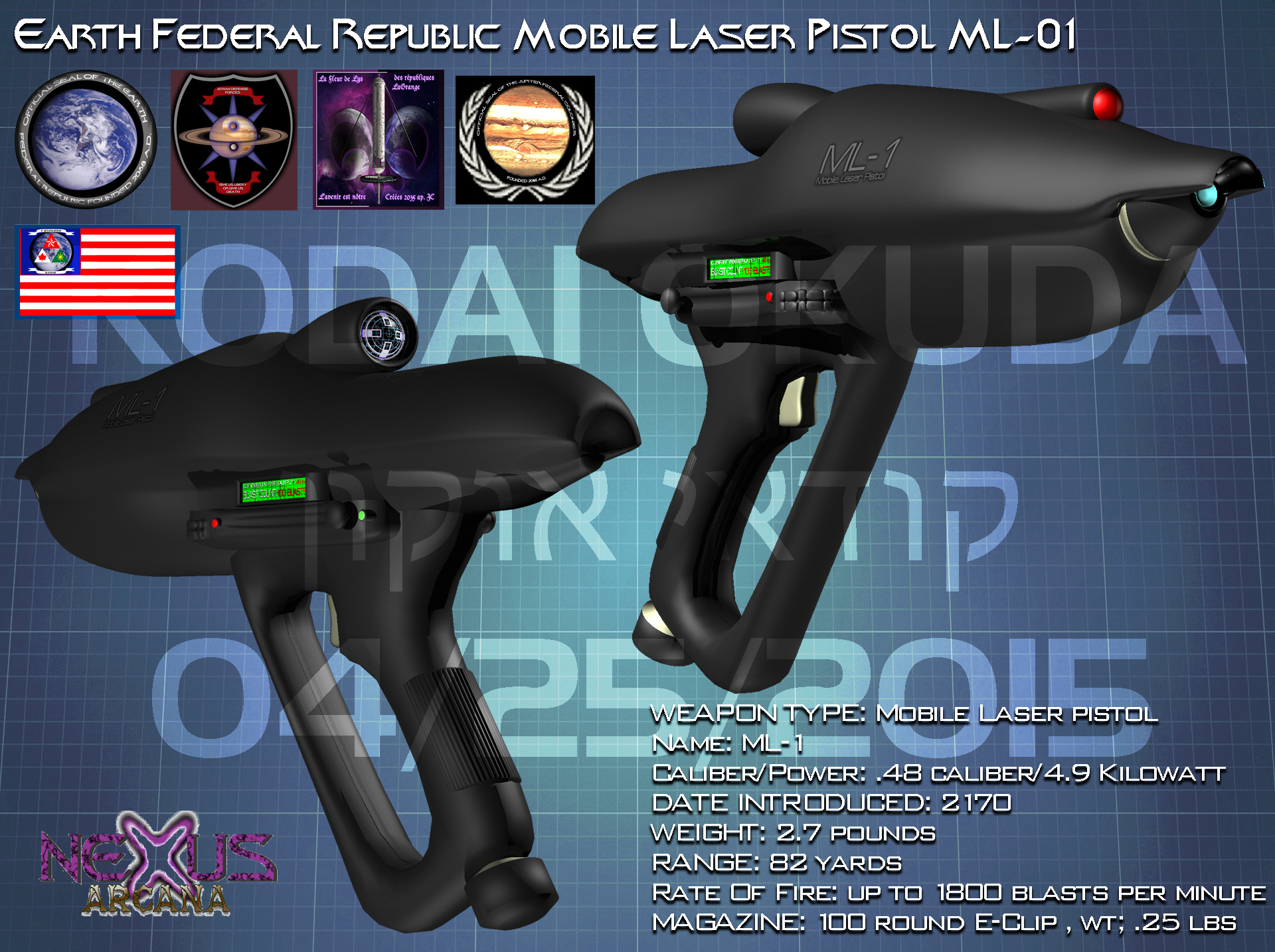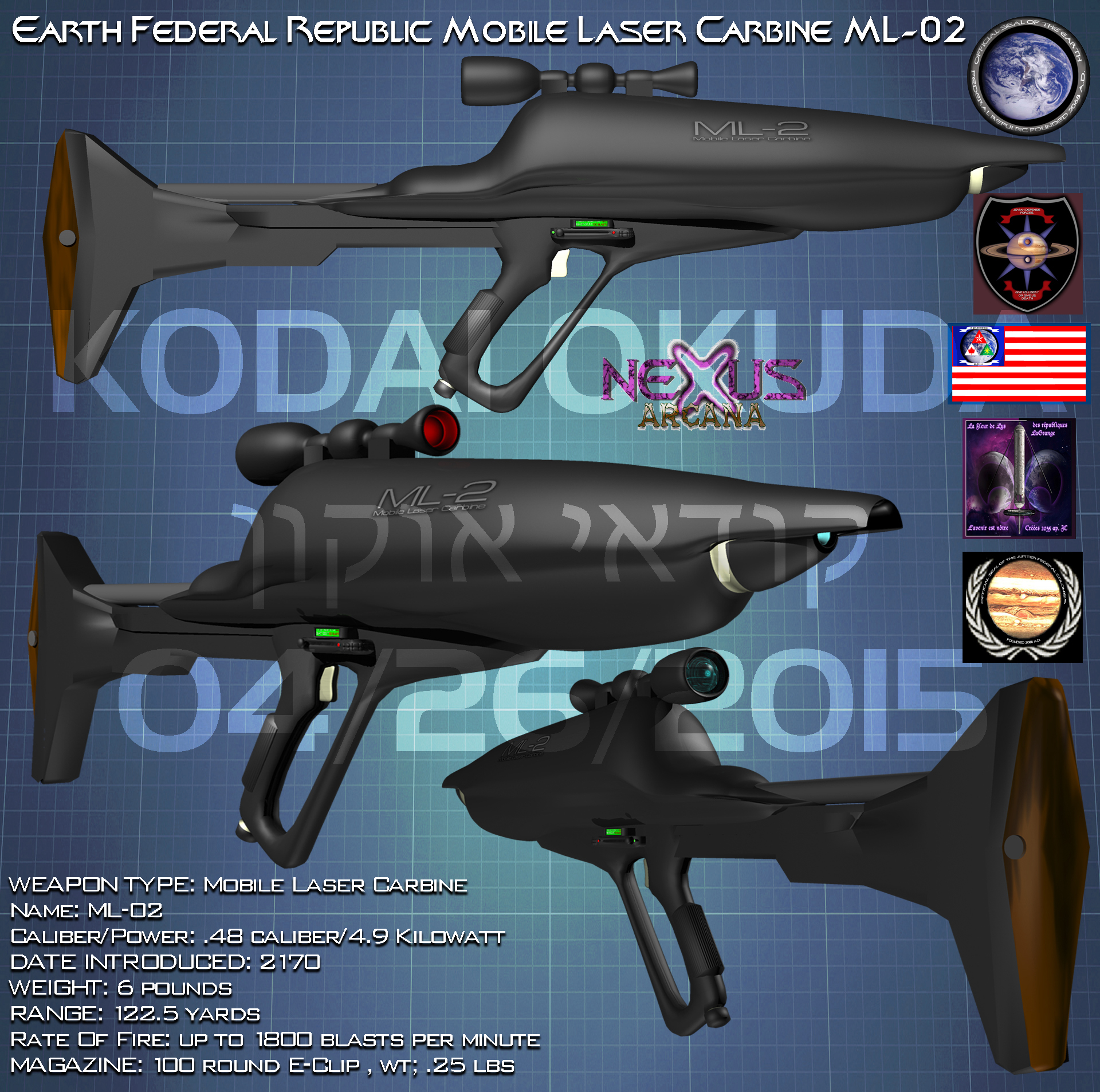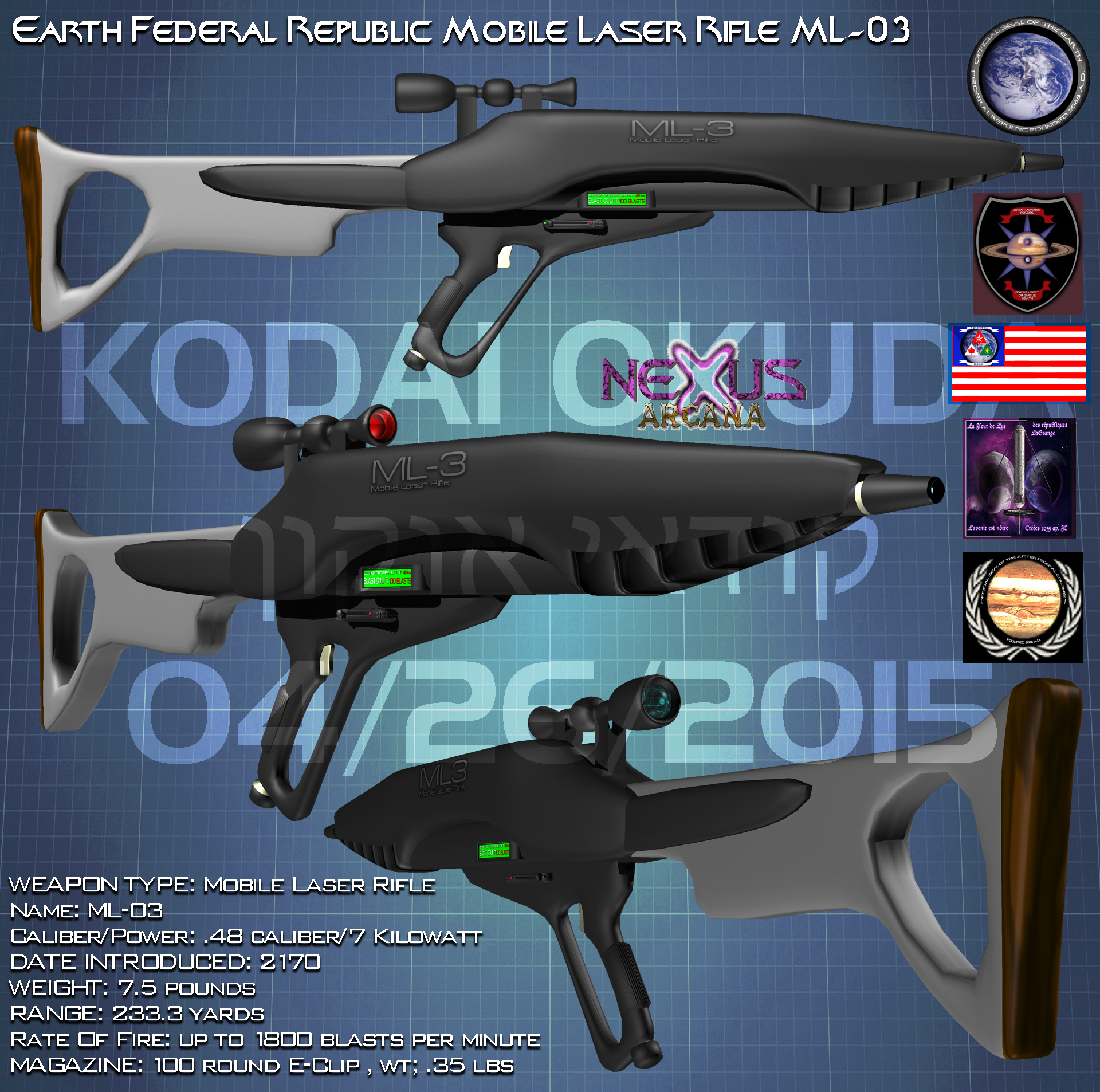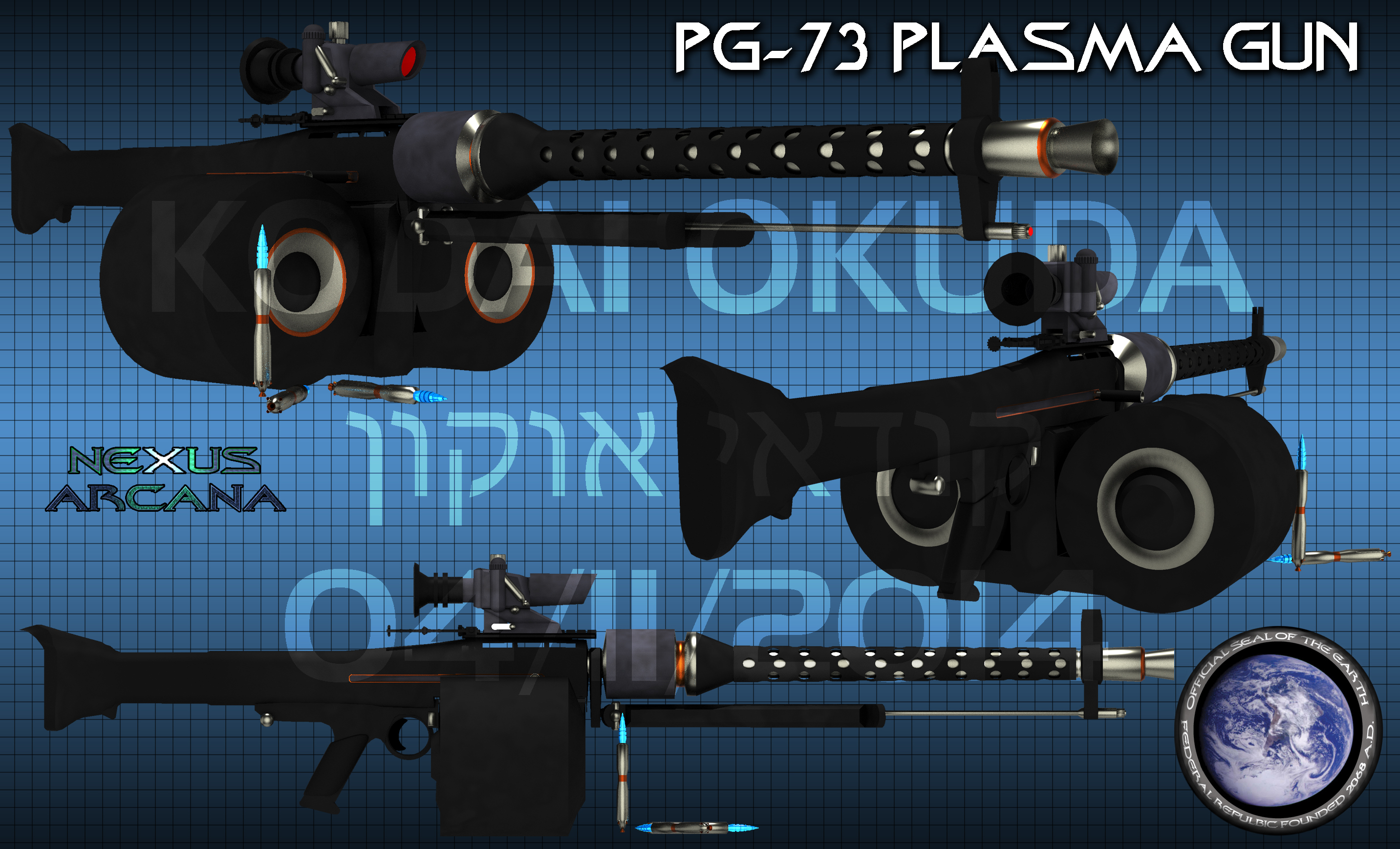Just prior to the start of the 1st Interplanetary War, and for the first two years of the war, the EFSM used surplus weaponry and equipment from the USSN and older EFR weapons stores. Thus, it was not unusual for spacemarines to arm themselves with LAR-51 battle rifles or PG-62 plasma rifles, and wear HCA-01 or USSN EVA-01 hard-armor.
After the Battle of Ceres in 2171 AD however, the Earth Federal Space Marines were issued the same small arms and equipment as all of the other Earth Federal Forces (EFSN and planetary defense forces). Therefore, the EFSM used the ML-1, ML-2, and ML-3 laser weapons and the PG-74 plasma gun as their
principle small arms. The equipment of the EFSM consisted of the LCA-01 and HCA-01 combat armors.
 |
ML-01:
ML-1:
Nippon Military Industries built the ML-1 laser pistol as a replacement for the numerous small-caliber firearms still in use by the USSN and EFR forces. Introduced in 2170, this weapon was one of two types of energy weapons built by Nippon Military Industries for both the professional armed forces and the citizen militia forces of the Earth Federal Republic. This weapon was a .48 caliber, 4.9-kilowatt laser pistol with both semi-auto and tri-burst capability. Its detachable energy-clip had a 100-blast capacity. This weapon was used by the Earth Federal Space Navy, Earth Federal Space Marines, Jovian Defense Forces, LaGrange Republics, United States Space Navy (at Juno), and Jupiter Federal Colonies. It was a very popular and effective weapon.
The Damage of the laser pistol is 4-40 megajoules of energy per blast (has a slide energy setting on the side and digital read out to tell you the laser output in kw). A full power blast at the optimum range of 82 yards (75 meters) or less has an equivalent damage to that of a modern 20mm cannon. While the lowest setting is equal to a 7.62 NATO (7.62 x 51mm) rifle round.
It will kill a non-armored human target with one blast at full power and inflict damage similar to a .308/7.62mm rifle round at .49 kilowatts power setting (lowest). Damage can be upped in increments of .49 Kw for 10 settings: .98 kw, 1.47 kw, 1.96 kw, 2.45 kw, 2.94 kw, 3.43 kw, 3.92 kw, 4.41 kw, 4.9 kw. Damage (energy) range in megajoules for each setting is as follows (from lowest to highest): 4, 8, 12, 16, 20, 24, 28, 32, 36, 40.
The weapon is intended to be used against armored soldiers (in combat armor or exosuits).
It has 100 full power blasts or up to 1000 low power blasts (or any combination not exceeding its full e-clip power charge of 490 Kilowatts).
NOTE: This weapon is considered "mobile" because it uses a detachable e-clip power pack that allows it to be used independently of a cable with power-pack-utility-belt that older laser weapons (mostly experimental) required. |
 |
ML-02:
ML-2:
The ML-2 was the second weapon built by Nippon Military Industries for the EFR professional military forces and the citizen militia groups. Another of Nippon Military Industries light-weight, injection-molded, plastic-steel weapons, this laser carbine was very popular with mecha and space fighter pilots as well as Space Navy crew members and security details. This .48 caliber, 4.9-kilowatt laser weapon was capable of single or tri-burst modes and uses the same 100-shot detachable battery clip as the ML-1. This was due mostly to the fact that the ML-2 used the same beam emitter system as that of the the ML-1 and didn't need extra power in its energy-magazine. The increase in energy damage of the ML-2 was due to the weapon's larger laser generation system in the front of the of the carbine. This carbine was used by the same powers as the ML-1.
The ML-2 could inflict from 6-60 megajoules of damage (energy) to a target and had the same type of 10 stage power selector as that of the ML-1, only the megajoule damage was slightly more than that of the ML-1 (about 30% more). |
 |
ML-03:
Norking Weapons was the contractor who won the Earth Federal Forces infantry small arms contract and thus built the first mass-produced laser rifle weapons. The ML-3 was a .48 caliber, 7-kilowatt laser rifle capable of firing in single shots or triple bursts. This laser weapon had a much longer range than either the ML-1 or ML-2 and shot a more powerful laser bolt. This weapon used a 100-blast detachable battery clip, which was not compatible with either the ML-1 or the ML-2 laser weapons.
The ML-3 could inflict from 10-100 megajoules of damage (energy) to a target and had the same type of 10 stage power selector as that of the ML-1 and ML-2, only the megajoule damage was slightly more than that of the ML-1 (about 30% more). |
 |
PG-73 Plasma Gun:
The PG-62 was an extremely successful design and very effective against UN armored vehicles. However, the PG-62 suffered from one shortcoming, that being its small magazine capacity. Therefore, as the war against the UNSC progressed, calls for a new plasma gun with more of a “punch” and more rounds began. Due to the political climate of the EFF during the second year of the 1st Interplanetary War, these demands for a new plasma weapon went unanswered. However, after the UN invasion of the Earth sphere in early 2173, the need for a new plasma rifle became glaringly apparent. The weapon was slow to develop and produce while the UNSC occupied much of the EFR surface-based mining and industrial complexes. However, the weapon designs were smuggled off of Earth to the EFSN base at Juno in late 2173 where the rifle was mass produced starting in early 2174. By February of that year, the PG-73 was ready for use in “Operation Clean Sweep.” The PG-73 was instrumental in the expulsion of the UN forces on Earth and Luna. The PG-73 remained the primary plasma rifle throughout the 2170s and early 2180s, completely replacing the PG-62 in the armories of the EFF by 2180 AD.
|
 |
Earth Federal Republic Environmental Combat Armor:
LCA-01 Heavy Combat Armor
The space suit and combat armors of the EFR prior to 2168 were primitive when compared to the alien specimens the EFR science teams found in the lockers of the alien spaceship that crashed in the Ross Sea off the coast of Antarctica. The old EVA suit and combat armors were bulky and relied heavily on 21st-century design concepts for their basic construction. Therefore, like with the new weapon systems, the Federal Senate of the EFR called for the creation of new, more versatile EVA suits. Both suits had to be able to withstand combat conditions. The light version, which became known as the LCA-01, was intended for use by SpaceNavy personnel on ship as well as spacefighter, tank, vehicle, and battlerobot pilots.
HCA-01 Heavy Combat Armor
The heavier version of the two newly developed Extra-Vehicular Activity suits was the HCA-02. This armor was designed specifically for use by infantry, security personnel, militia forces, and Regional Guard units.
|

